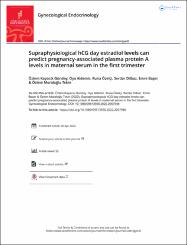Supraphysiological hCG day estradiol levels can predict pregnancy-associated plasma protein A levels in maternal serum in the first trimester

Göster/
Erişim
info:eu-repo/semantics/embargoedAccessTarih
2022Yazar
Kayacık Günday, ÖzlemAldemir, Oya
Özelçi, Runa
Dilbaz, Serdar
Başer, Emre
Moraloğlu Tekin, Özlem
Üst veri
Tüm öğe kaydını gösterKünye
Kayacık Günday, Ö., Aldemir, O., Özelçi, R., Dilbaz, S., Başer, E., & Moraloğlu Tekin, Ö. (2022). Supraphysiological hCG day estradiol levels can predict pregnancy-associated plasma protein A levels in maternal serum in the first trimester. Gynecological Endocrinology, 1-6.Özet
Objective
To investigate the effect of hCG day estradiol (hCG-E2) used in Down Syndrome screening on maternal serum levels of PAPP-A in fresh in vitro fertilization (IVF) cycles.
Methods
This study was a retrospective analysis of a cohort that resulted in a single pregnancy after a total of 92 fresh IVF cycles. The primary outcome of this study was to determine the effect of fresh IVF cycle parameters on the PAPP-A level and the cutoff value for hCG-E2 predicting a low PAPP-A level, while the secondary outcome was to determine whether the effect of IVF parameters on the PAPP-A level was significant.
Results
There was a negative correlation between PAPP-A levels and the number of hCG-E2 and grade 1 embryos (respectively, p = .049; .047), while a positive correlation was observed between baby weight at birth and the PAPP-A (p < .05). At a PAPP-A value of 0.82, the difference between the two groups, in terms of hCG-E2, the number of grade 1 embryos, and pregnancy-related complications was significant (p = .050; .029; .033, respectively). The threshold value of hCG-E2 affecting PAPP-A levels was statistically significant (AUC = 0.618; p = .050; hCG-E2 = 4869.5 pg/ml). In the model, an increase in the number of grade 1 embryos resulted in higher PAPP-A levels (OR = 2.26; p = .044).
Conclusion
The fact that the hCG-E2 cutoff value, which lowers PAPP-A, reflects excessive ovarian stimulation argues for the correction of the dual screening test in a subset of patients with high response to the first-trimester screening test.















